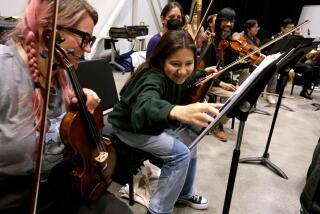In the hands of these masters, a new meaning to jingle bells
- Share via
When she was in high school, Susan Ullom Hungerford recalls being part of her school’s hand-bell group and performing classic Vince Guaraldi “Peanuts” songs onstage in a giant Snoopy costume.
“The bells were lined up on the floor and it was really hard to find them wearing the giant head,” she says with a laugh. “Glad I didn’t fall.”
Tonight, Hungerford will forgo wearing a cartoon canine head for something more holiday-infused when she leads members of the South Coast Handbell Ensemble in a yuletide concert at the Bowers Museum in Santa Ana.
Performing songs of the season, Hungerford and 13 ringers of the five-plus octave group will work up a sweat as they harmoniously chime, peal and ding-dong 63 brass and aluminum bells.
Think it’s easy? Hungerford will invite audience members onstage to learn what it takes to ring like a pro.
There are specific ways, she says, to make the bell note stop suddenly or reverberate. Hand bells are played sweet and soft or harsh and powerful. “It’s all in the flick of the wrist,” she says.
Newbies may also get a chance to try the four-in-hand technique that involves holding two bells in each hand. Be mindful of the lower registry bells -- those monsters can weigh as much as 11 pounds.
Despite occupational hazards (“We have to worry about wrist damage, carpal tunnel and even tendinitis”), ringers groove on the highly coordinated effort; each member is usually responsible for four bells, and some musicians take on eight or nine. Bells are set up similarly to keys on a piano, except higher notes are positioned on the left.
“It’s really one instrument, not a series of 37 or 52 bells,” says Hungerford.
Hand-bell history goes back to the 1600s in Europe, where they were fashioned as rehearsal instruments for bell tower players or “change ringers” (those who played bells in mathematical patterns, or “changes”). These teams, usually consisting of daytime field workers, needed a way to practice their complicated melodies.
Rehearsal in the tower was too conspicuous, not to mention annoying in the evening hours.
With hand bells in tow, change ringers turned local taverns into rehearsal spaces, ringing up a storm between pints.
Later, hand bells hit vaudeville circuits and eventually found homes in churches, schools and community-based groups.
Hungerford is adamant that “hand-bell music isn’t just for churches or religious services; it can be very accessible for other types of music.”
She remembers her former Indianapolis hand-bell group startling its audience by swinging out to a Take Five jazz arrangement. “You could see their jaws drop,” she says. “They were expecting to hear ‘A Mighty Fortress.’ We showed them bells can do anything.”
-- Brenda Rees
--
SOUTH COAST HANDBELL ENSEMBLE: YULETIDE CELEBRATION
WHERE: Norma Kershaw Auditorium, Bowers Museum, 2002 N. Main St., Santa Ana
WHEN: 7 tonight
PRICE: $12 adults, $8 kids 10 and younger, free for children 6 and younger
INFO: (714) 567-3600
More to Read
The biggest entertainment stories
Get our big stories about Hollywood, film, television, music, arts, culture and more right in your inbox as soon as they publish.
You may occasionally receive promotional content from the Los Angeles Times.









